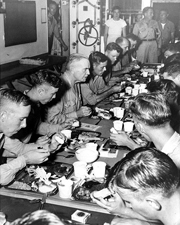350 Years of New Jersey History |
||
New Jersey
350 years of
History
Official New
Jersey 350
Year Website
INDEX
(To view
previous sites
select below:)
New Jersey - 350 years of Innovation |
||
 |
 |
Bell Labs Union County, Murray Hill Holmdel Township, Monmouth County National Historic Landmark |
Begun in New York City in 1925, the labs moved in 1941 to Murray Hill in New Providence, Union County. Murray Hill remained Bell Labs' primary headquarters, but a satellite campus was built in Holmdel, Monmouth County, where an office building designed by internationally-famous architect Eero Saarinen opened in 1961. At its height, Bell Labs employed about 15,000 people in an astonishingly wide variety of specialized fields. Bell Labs not only had staff who could conceive innovations, they could also discover the science to explain them, make the working models to demonstrate them, and transform prototypes into actual products. Because of the aura that surrounded Bell Labs, it often seemed that the Bell Telephone System itself somehow belonged to New Jersey in the mid-20th century. The story of Bell Labs is explained more fully in Jon Gertner, The Idea Factory: Bell Labs and the Great Age of American Innovation (2012); Jeremy Bernstein, Three Degrees Above Zero: Bell Labs in the Information Age (1984); and John Brooks, Telephone: The Wondrous Invention that Changed a World and Spawned a Corporate Giant (1976). Search the following terms online: Bell Labs, transistor, Unix, systems theory, and Horn Antenna. |
||
 |
 |
|
Horn Antenna, Bell Labs, Holmdel Township.
|
Bell Labs, Murray Hill. Courtesy of The Porticus Centre, Beatrice Technologies, Inc., Subsidiary of Beatrice Companies, Inc. |
|
| For more information on this site and subject, search the following terms: “Bell Labs”, “Bell System History”, “Horn Antenna” | ||
New Jersey - 350 years of Liberty |
||
 |
 |
USS New Jersey (BB-62) Camden County, City of Camden National and State Registers of Historic Places |
One of four Iowa class battleships built, construction of the New Jersey began at the Philadelphia Naval Shipyard in 1940. The ship was launched on December 7, 1942, exactly one year after the Japanese attack on Pearl Harbor and the United States' entrance into World War II. She began active combat duty in early 1944 and in August of that year became the flagship of Admiral William F. "Bull" Halsey, Jr., Commander of the Pacific Third Fleet and a native of New Jersey. The New Jersey and her crew served valiantly in many of the major campaigns in the Pacific Theatre of the war, earning a total of nine battle stars. The New Jersey was decommissioned in 1948, but reentered active service in 1950 during the Korean Conflict and again in 1968—the only U.S. battleship recalled to active duty during the Vietnam War. The New Jersey was commissioned for a fourth and final time in 1982, seeing combat service during the Lebanese Civil War in 1983-1984. The ship was decommissioned for the final time in February 1991. In November 1999, the New Jersey returned to the Philadelphia Naval Shipyard, where her story began almost 60 years earlier. A few months later, the Navy announced that the ship would be donated to the Home Port Alliance of Camden and opened to the public for use as an educational museum. Following an extensive restoration, the New Jersey made the short trip up the Delaware River to her new home along the Camden waterfront, where visitors may explore this incredible example of 20th-century naval technology, and learn about the role of the ship and its courageous sailors in defending our nation's freedom. (Top Photograph) USS New Jersey's guns firing off the coast of Lebanon, 1984. Courtesy U.S. Department of Defense |
||
|
 |
|
| Adm. WIlliam F. Halsey, Jr. dines with the crew 1944. Courtesy U.S. National Archives | USS New Jersey on the Camden waterfront. Courtesy Home Port Alliance for the USS New Jersey | |
For more information on this site and subject, visit http://www.battleshipnewjersey.org/ |
||
Abbott Farm
Union County, Murray Hill
Holmdel Township, Monmouth
County National Historic Landmark
The Abbott Farm National Historic Landmark is located near Trenton on the terraces overlooking the Delaware River and tidal marshes comprising a rich diversity of environmental and cultural resources. The Abbott Farm was named after its owner, Charles Conrad Abbott (1843-1919), a noted scientist, naturalist, and American archaeologist, who authored numerous publications beginning in 1872 on the Native American artifacts he uncovered on his farm. These discoveries sparked a forty-year international debate and controversy regarding the antiquity of humans in the New World, and played a significant role in the developmental stages of American archaeology and geology. Many of American’s most distinguished geologists, paleontologists, and archaeologists and several leading European scholars participated in the debate. The controversy made Abbott Farm one of the best known eastern North American archaeological sites to European and American scientists and to the American public.Building on the works of Charles Abbott and Ernest Volk, State Archaeologist Dorothy Cross conducted large-scale excavations at the Abbott Farm (1936-1940), through assistance of the Works Progress Administration, identifying the expansive remains of Native American Archaic through Woodland period (6,000-1,500 B.P.) settlements, burying grounds, and resource processing locations. While less visible, evidence was also identified for all periods of Native American occupation of North American including Paleo-Indian (12,000 B.P.) through European Contact.
The Abbott Farm is one of the most significant prehistoric archaeological sites in the eastern United States with archaeological studies continuing to the present day.
(Note: Before Present (B.P.) is a time scale used in scientific disciplines to specify when events in the past occurred. Because the "present" time changes, standard practice is to use January 1, 1950 as commencement date of the age scale, reflecting the fact that radiocarbon dating became practicable in the 1950s.)
(Top Photograph) Charles Conrad Abbott circa 1904. Courtesey findagrave.com
Courtesy New Jersey State Museum
John White painting of an Algonquian tribal member circa 1590. Courtesy The British Museum(Above right) For more information on this site and subject, search the following terms: “Abbott Farm” “Charles Conrad Abbott” “Native American Archaeology Abbott Farm”
|
|
| |






